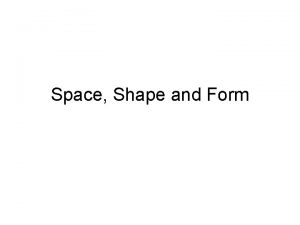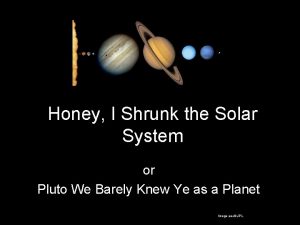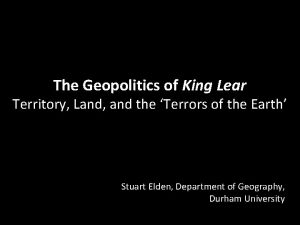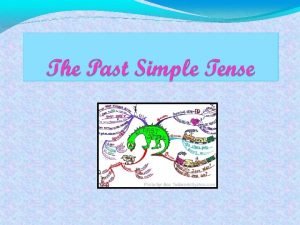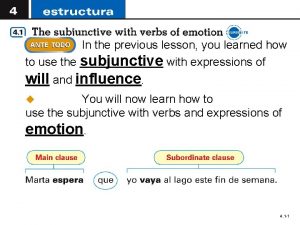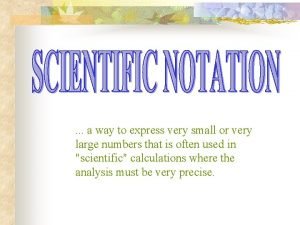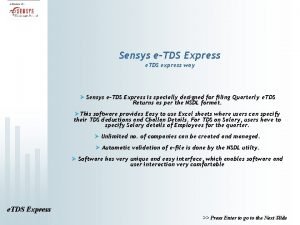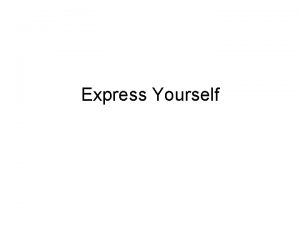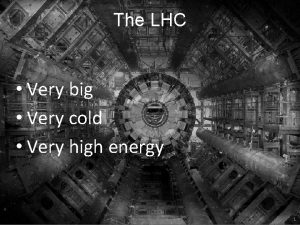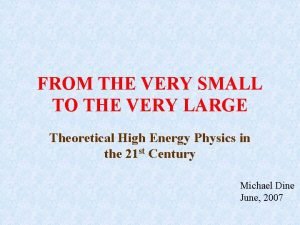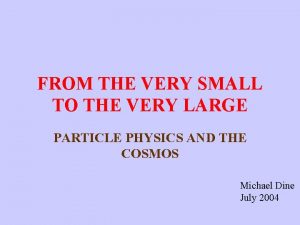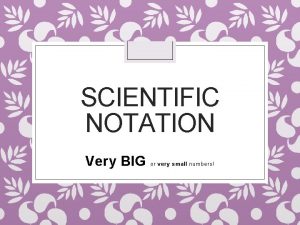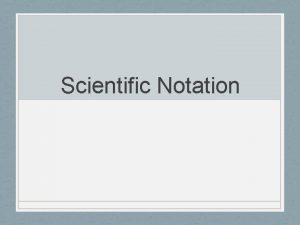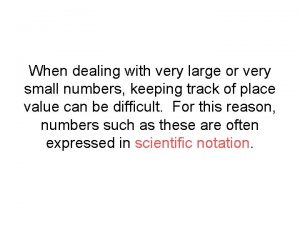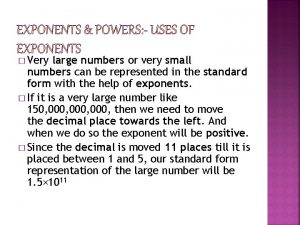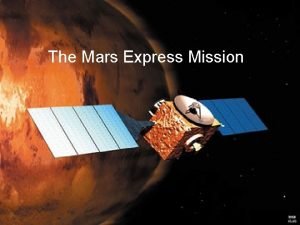a way to express very small or very























- Slides: 23

. . . a way to express very small or very large numbers

A number written in Scientific Notation has three parts… A number greater than one but less than ten A multiplication sign A power of ten

Standard Form to Scientific Notation: (1) Move the decimal point so that the number is greater than one but less ten. (2) Remove any insignificant zeros. (3) Count number of decimal places the decimal has "moved" from the original number. This will be the exponent of the 10. (3) If the original number was a small number, the exponent is negative; if the original number was a big number, the exponent is positive.

Try the following Problems: 61, 500 = 84, 960, 000 = 321 =

0. 000527 = 0. 0000004 = 0. 004503 = REMEMBER: the first number must be greater than 1, but less than 10. Therefore, the number before the decimal point can be 1, 2, 3, 4, 5, 6, 7, 8, or 9.

Scientific Notation to Standard Form:

Scientific Notation to Standard Form: (1)Move the decimal point the same number of spaces as the exponent. (2)Positive exponents = big numbers, so move the decimal point to the RIGHT. (3)Negative Exponents = small numbers so move the decimal point to LEFT (4)Fill in any empty spaces with zeros and rewrite the number.

Try the following problems 109, 000 42, 273 0. 00942

Comparing Numbers in Scientific Notation:

Comparing Numbers in Scientific Notation: (1)First compare the powers of ten. (2)Then compare the decimal values.

Try the following problems Refer to the table at the right. Order the countries according to the amount of money visitors spent in the United States from greatest to least. United Kingdom, Canada, Mexico, India. Tell whether the following number is correctly written in Scientific Notation. Explain how you know. No, because 16. 2 is not a number between one and ten. It should be 1. 62 x 105

Multiplying Numbers in Scientific Notation:

Multiplying Numbers in Scientific Notation: (1)We use the Commutative and Associative properties. (2)Multiply the decimals. (3)Then multiply the powers of 10 by adding exponents. (4)Write in scientific notation.

Try the following Problems: Evaluate (7. 2 x 103)(1. 6 x 104) 1. 152 x 108 Evaluate (8. 4 x 102)(2. 5 x 106) 2. 1 x 109 Evaluate (2. 6 x 104)(1. 2 x 10 -3) 3. 1 x 10 The volume of a drop of oil is 0. 00002 liter. Find and write the volume of 8 drops of the oil in scientific notation. 1. 6 x 10 -4

Dividing Numbers in Scientific Notation:

Dividing Numbers in Scientific Notation: (1)We use the Commutative and Associative properties. (2)Divide the decimals. (3)Then divide the powers of 10 by subtracting exponents. (4)Write in scientific notation.

Try the following Problems: Evaluate 6. 3 x 104 2. 375 x 1011 3. 75 x 10 -19 Central Park in NYC is rectangular in shape and measures about 1. 37 x 104 feet by 2. 64 x 102 feet. If one acre is equal to 4. 356 x 104 square feet, how many acres does Central Park cover? Round to the nearest hundredth. 83. 03 acres

Adding Numbers in Scientific Notation:

Adding Numbers in Scientific Notation: (1)The numbers need to be expressed in the same form. (2)This means to rewrite with the same exponents. (3)Then factor the GCF (powers of 10). (4)Line up the decimals to add. (5)Write in scientific notation.

Try the following Problems: Evaluate (6. 89 x 104) + (9. 24 x 105) 9. 929 x 105 Evaluate 593, 000 + (2. 5 x 106) 3. 093 x 106 Evaluate (8. 9 x 109) + (4. 2 x 106) 8. 9042 x 109 The length of a rectangle is 1. 656 x 10 -3. The width of the rectangle is 5. 52 x 10 -4. Find the perimeter of the rectangle in scientific notation. 4. 356 x 10 -3

Subtracting Numbers in Scientific Notation:

Subtracting Numbers in Scientific Notation: (1)The numbers need to be expressed in the same form. (2)This means to rewrite with the same exponents. (3)Then factor the GCF (powers of 10). (4)Line up the decimals to subtract. (5)Write in scientific notation.

Try the following Problems: Evaluate (7. 83 x 108) - 11, 610, 000 7. 7139 x 108 Evaluate (9. 64 x 108) - (5. 29 x 106) 9. 5871 x 108 Evaluate (1. 35 x 106) – 117, 000 1. 233 x 106 The Earth is 92, 957, 100 miles from the Sun and Mercury is 35, 983, 610 miles from the Sun. About how much further is Earth from Mercury? 5. 697349 x 107
 Scientific notation rules
Scientific notation rules Quantifiers for milk
Quantifiers for milk Figure 10
Figure 10 There is very few soup in the bowl
There is very few soup in the bowl It is a very shallow skillet with very short sloping sides
It is a very shallow skillet with very short sloping sides What is an atom made of
What is an atom made of Small areas of white used to show the very brightest spots
Small areas of white used to show the very brightest spots Sistema solar
Sistema solar Principles of conventional software engineering
Principles of conventional software engineering Apa itu two way anova
Apa itu two way anova Perbedaan anova one way dan two way
Perbedaan anova one way dan two way The one was a ship
The one was a ship Relative frequency two way table
Relative frequency two way table One-way anova hypothesis testing
One-way anova hypothesis testing Talk this way
Talk this way Two way anova
Two way anova One way anova vs two way anova
One way anova vs two way anova Threaded binary tree in data structure
Threaded binary tree in data structure Phani jammalamadaka
Phani jammalamadaka Terrors of the earth king lear
Terrors of the earth king lear Simple past usage
Simple past usage Lili.org learning express
Lili.org learning express Ojalá que ellos (descubrir) nuevas formas de energía
Ojalá que ellos (descubrir) nuevas formas de energía Eating or drinking verbs that express anger
Eating or drinking verbs that express anger






